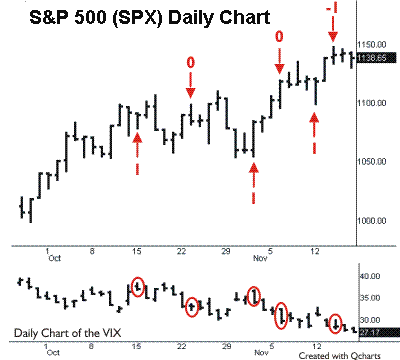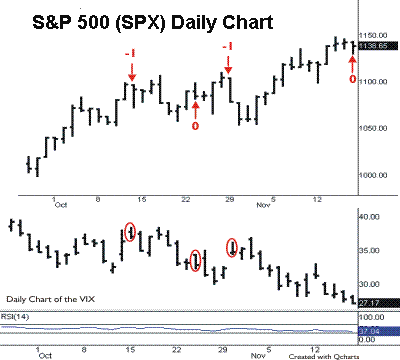How To Use TM’s Indicators: The Market Bias Page
TradingMarkets’
Market
Bias Indicators are used to identify a potential
directional bias in the overall market, for the upcoming 1-3 trading
days. While not a mechanical trading system, these signals help
the trader stay alert to shifts in sentiment which can bring
about short-time market reversals. Astute traders can use them to index
trading vehicles such as the S&P futures, QQQs or E-minis. In addition, they can be
used to improve the timing of entries into individual stocks, to establish positions
that are in sync with the overall short-term trend of the market.
Years of
research and testing have gone into designing these market-timing indicators, in
order to give traders an “edge†in the markets. As discussed in Connors
On Advanced Trading Strategies, Trading
Connors VIX Reversals and Dave
Landry’s Swing Trading, their proper use requires an
understanding of what having an “edge†on the markets is:
Basically,
when one of the Market Bias indictors issues an alert, it is telling you that
the market has a better than 50% chance of making a short-term move in the
direction indicated.
With this
alert in place, the trader now
has an “edge†on the markets. This does not necessarily equate to a viable
trading opportunity, however. Making that determination is up to the trader’s
discretion. But whatever trading setup you do identify, knowing that the
overall market has the potential to favor a certain direction gives you an
edge.
To increase
your chances of succeeding in the markets, TradingMarkets provides several
different Market Bias Indicators which issue alerts collectively. The more
indicators pointing in the same direction, the more likely the move will happen.
Of course, not every indicator is right all the time, and in some situations,
the markets will move contrary to these alerts.
The
indicators can be used for any style of trading. Each signal is designed to
forecast the market direction, until it signals otherwise. Swing traders can use
the momentum to better time their entries and exits, while daytraders can better
predict the next day’s momentum. Using stocks from the Proprietary
Momentum List and Proprietary
Implosion List will also increase your edge. Having a solid money management
system is also a crucial aspect of success with the indicators, although
that’s a topic for another lesson. For a deeper understanding of
the workings of each Market
Bias Indicator, just click on the links below.
Indicators
Defined
The VIX is a measure of the
consensus estimate of future volatility, based on “at-the-money” quotes
of OEX index options. This is basically a measure of sentiment, with low VIX
readings reflecting complacency and high VIX readings reflecting fear in the
markets. Low VIX readings typically occur when the market is rising, and high
VIX readings typically occur when the market is falling. The signals given by TM
are discussed thoroughly in the book Trading
Connors VIX Reversals by Larry Connors and Greg Che.
Connors
VIX Reversal III CVR III
The McClellan
Oscillator is a
popular instrument that measures breadth by taking the number of advancing
issues, less the number of declining issues, and subtracting the 39-day EMA from the 19-day
EMA of net
advances. When the 19-day EMA has crossed above the 39-day EMA, advancing
issues have gained the upper hand. Conversely, when the 19-day EMA has gone below the
39-day EMA, declining issues are in command. For the Market Bias page, an up arrow
signifies a McClellan reading of -100, which is oversold, and a down arrow
signifies an oversold condition with a reading of +100.
The
Connors-Hayward Advance/Decline Trading Pattern, CHADTP,
is a proprietary indicator that measures the NYSE’s
advancing/declining issues, to identify short- to intermediate-term overbought
and oversold conditions in the stock market and the S&P 500 futures. When
the CHADTP is above +400, the market is overbought; when the CHADTP is below
-400, it is oversold. Possible reversals are indicated when the
indicator ticks down when it is overbought or ticks up when it is oversold.
The TRIN is
the short-term NYSE Trading Index, generated by
combining advancing and declining stocks with volume. Readings under 1.00
signify a strong market; readings above 1.00 signify a weak market. A
TRIN-Thrust day (a change of .30 or more) signifies the likelihood of some market
follow-through the next day. An up-move of .30 or more indicates the market has
a downward bias for the upcoming day; a down-move of .30 or more signifies an
upward bias for the upcoming day. TRIN Thrusts are not to be used as a stand-alone indicator. They should be combined with another
indicator (or indicators) that also points to a move in the same direction.
The TradingMarkets.com
Momentum
Index Indicator uses
a proprietary mathematical formula to create an unweighted basket of the
strongest stocks — those the “smart money” is moving into. These stocks
tend to front-run the overall market by a day or less. This
means if the overall market is down for the day and the TMI closes higher, there
is a better-than-average chance the overall market will be higher the next day.
Conversely, if the overall market is up for the day and the TMI closes lower,
there is a better-than-average chance the overall market will be lower the next
day.
Examples
*All charts use the
following symbols: 1 = Buy Signal, -1 = Sell
Signal, 0 = Exit Position.
The accompanying rules are
from the book Trading
Connors VIX Reversals by Larry Connors and Greg Che.
In the first example, we have a
CVR I signal marking buy and sell points on the S&P 500 Index.

As you can
see, the signals alerted us to shifts in the market that were potential entry
points. Some of the signals obviously worked better than others, though the edge
here is evident. The original design of this signal was tested and recommended
with these rules:
For Buys
(Reverse for Sells)
-
Today the VIX must
make a five-day high. -
Today the close of
the VIX must be below the open. -
If Rules 1 and 2
are met, buy the S&Ps (or the market) on the close of today. This will
have to be done at the same time Rule 2 is met in the last few minutes of
trading. -
Hold the position
at least 1-3 days.
Though the
original design was for swing traders, daytraders can easily incorporate these
signals into a strategy by anticipating potential market direction.
In the
second example, we have a CVR II signal.

Here we see
choppier price action following the signals, which reinforces the importance of stop
losses. These signals are from the same time period of the first example,
yet are signaling different entries. The advantage of having different VIX
signals generated is that it can take advantage of different market climates.
Any indicator can outperform or under-perform the others at
any time, so it is important to tune into all of them to try to get as clear a
picture as possible. Multiple signals in the same direction increase the chances of
that move. The rules for CVR II signals were designed with the following
recommendations:
1.
Take a five-period
RSI of the closing VIX.2a.
When
the five-period RSI gets to 70 or above, it signifies the VIX is overbought and
the market is oversold.2b.
When
the five-period RSI of the VIX gets to 30 or below, it signifies that the VIX is
oversold and the market is overbought.3.
When a
daily RSI reading above 70 is followed by a downtick in RSI, buy the market that
day on the close. When an RSI reading below 30 is followed by an uptick in RSI,
sell the market that day on the close.4.
Exit 2-3 trading days later (or use some type of trailing-stop exit).
In the
third example, we have a CVR III signal.

As you can
see in the chart above, the indicators are providing desirable entries. Again, a
good money management system can make all the difference in your level of
success with these indicators. When you exploit an edge on the market, you must
also be disciplined enough to exit the trade when your stop-loss has been hit. The
rules for these signals were recommended with the following:
For Buys
(Reverse for Sells):
-
Today
the low of the VIX must be above its 10-day moving average. -
Today
the VIX must close at least 10% above its 10-day moving average. -
If
rules 1 and 2 are met, buy the market at the close. -
Exit
(on the close) the day the VIX trades (intraday) below yesterday’s 10-day
moving average (reversion to the mean), or exit within 2-4 days.
In our fourth example, we have
a CVR VI signal.

The signals
here are demonstrating entry points that are once again setting up profitable
moves. Does this work all the time? No. The first -1 sell signal in
this example was reinforced with other CVR signals cited in the examples above. The
signals may not all trigger on the same day, but by looking at the Market Bias
Indicators page every day, you will get a good feel for what’s going on as the
signals come in. The rules for the CVR VI were recommended with the following:
For Buys
(Reverse for Sells):
-
The VIX
must make a new 20-period low two out of the past three days. -
When
this occurs, sell the market on the close. -
Exit in 2-3 days.
Summary
Good money
management is essential with any trading methodology. Reliable as these signals
may be, trading off Market Bias page alerts is no different. Remember that these alerts are designed to give you an edge. We cannot
emphasize enough that multiple signals provide even better odds than individual
ones. While this edge
can give you an advantage when it is factored into your trading decisions, no system is
perfect. For best results, you must adjust numerous factors such position size,
entry levels, stop placement, etc.
